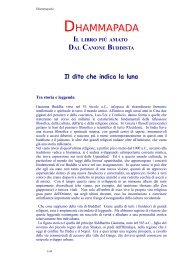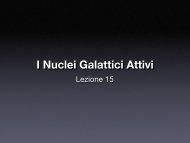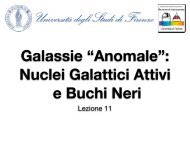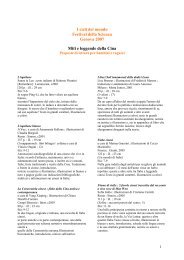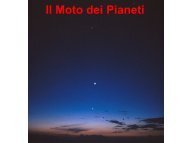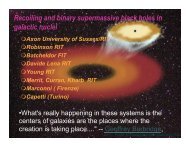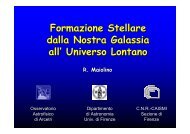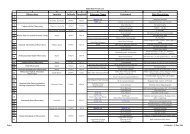from star-forming galaxies @ z~3-4 as
from star-forming galaxies @ z~3-4 as
from star-forming galaxies @ z~3-4 as
Create successful ePaper yourself
Turn your PDF publications into a flip-book with our unique Google optimized e-Paper software.
Galaxies, Near and Far<br />
Conference In honour of Bob Fosbury<br />
Lyman break <strong>galaxies</strong> at z>3 and their<br />
contribution to the ionizing UV background<br />
Eros Vanzella (INAF - Trieste)<br />
Collaboration<br />
GOODS Team, ESO-GOODS (+ INAF-OAR)<br />
Eros Vanzella - Perugia - May 2011
Outline<br />
HI Re-ionization, attack the problem <strong>from</strong> two sides, <strong>z~3</strong>-4 and z>7:<br />
- What are we learning (observationally)<br />
<strong>from</strong> <strong>star</strong>-<strong>forming</strong> <strong>galaxies</strong> @ <strong>z~3</strong>-4 <strong>as</strong> “stellar ionizers” ?<br />
- New ultra-deep limits on escaping ionizing radiation <strong>from</strong> <strong>star</strong>-<strong>forming</strong><br />
<strong>galaxies</strong> (GOODS) @ <strong>z~3</strong>.7<br />
- Approaching the re-ionization epoch, first <strong>galaxies</strong> confirmed at<br />
redshift beyond 7<br />
Eros Vanzella - Perugia 25 May 2011
Motivation: Motivation:<br />
HI reionization<br />
Ionized<br />
First light<br />
Reionization Neutral<br />
WMAP �� es<br />
→ Reion. began at z~10-15<br />
(Dunkle+09)<br />
QSO Gunn Peterson trough<br />
→ IGM ionized by z~6<br />
(Fan+06)<br />
- What sources were responsible<br />
for reionization ?<br />
- How reionization proceeds ?<br />
(e.g. Multi-ph<strong>as</strong>es; Clustering; etc.)<br />
- What keeps the Universe<br />
ionized down to lower redshift ?<br />
- ...
What reionize (and keep ionized) the Universe ?<br />
- the transmission of the IGM in extremely low at z>6,<br />
fesc directly <strong>from</strong> <strong>galaxies</strong> at the<br />
- QSOs ? Rapid decine in space density at<br />
z>2.5 it is impossible (Cowie+09; to Proch<strong>as</strong>ka+09).<br />
estimate the fesc<br />
Faint epoch end of slope reionization.<br />
? Not sufficient (Glikman+11).<br />
- Star-<strong>forming</strong> - me<strong>as</strong>ure fesc <strong>galaxies</strong> (i.e. LBGs) are<br />
the leading candidates at z>3, but ...<br />
fesc at z ~ 3 - 4 and relate these sources<br />
to objects at z > 6<br />
Question:<br />
What is the ionizing photon production<br />
rate <strong>from</strong> <strong>galaxies</strong> and their contribution<br />
to the global ionization rate of hydrogen ?<br />
Pawlik+09<br />
Faucher-Giguere+08<br />
We must chart the abundance (LF) and SFR <strong>as</strong> a<br />
function of time (redshift) and estimate fesc, fesc (escape fraction)<br />
of ionizing photons <strong>from</strong> <strong>star</strong>-<strong>forming</strong> <strong>galaxies</strong>
Estimating fesc: Method<br />
Intrinsic ionizing photons unknown:<br />
commonly adopted strategy<br />
is to compare the observed<br />
flux at LyC to the observed<br />
Flux at a frequency where<br />
the intrinsic emissivity<br />
can be inferred.<br />
Difficult me<strong>as</strong>ure !<br />
��m~5 m~5 → fesc~8% @ <strong>z~3</strong><br />
(Steidel et al. 2001, Shapley et al. 2006)<br />
FUV<br />
1500Å
fesc <strong>from</strong> <strong>galaxies</strong>: theoretical predictions<br />
Theoretical modeling (RT+SPH):<br />
fesc ↓ if redshift ↑ (Wood & Loeb+00)<br />
fesc ↑ if redshift ↑ (Razoumoz+06)<br />
fesc ↓ if halo m<strong>as</strong>s ↑ (Yajima+10)<br />
fesc ~ with redshift (Yajima+10)<br />
fesc ↓ if halo m<strong>as</strong>s ↓ (Gnedin+08)<br />
fesc ↑ for dwarf <strong>galaxies</strong><br />
(Wise&Cen+09)<br />
?<br />
Large variance on the predictions<br />
SF, feedback, radiation transfer and<br />
geomery of the ISM distribution,<br />
all important ingredients.<br />
Require a treatment of Radiative<br />
transfer
fesc <strong>from</strong> <strong>galaxies</strong>: current observations<br />
Z~0 fesc ~ 0.01-0.02 MW (Bland-Hawthorn & Maloney 1999; BH et al. 2001)<br />
fesc < 0.02-0.05 (spec. Leitherer+95; Deharveng+01; Grimes+07)<br />
Z~1 fesc < 0.02-0.05 (Siana+10; Malkan+03;Cowie+09)<br />
Z~3 fesc < 0.73 Inoue+05 (phot, 2 LBGs)<br />
< 0.15 Fernandez-Soto+03 (phot, 27 LBGs)<br />
< 0.16 Giallongo+02 (spec, 2 LBGs)<br />
< 0.05 Boutsia+11 (phot, 11 LBGs) (LBT deep, ApJ accepted)<br />
< 0.03 Vanzella+10c (phot, 102 LBGs, ApJ, 725, 1011)<br />
fesc ~ 1.0 ! (spec. Stacking; 30 LBGs, Steidel+01)<br />
fesc ~ 0.2 (spec. Stacking; 14 LBGs, Shapley+06)<br />
fesc esc > 0.2 (phot. NB, Iwata+09; Nestor+11 ~ 40 LBGs)<br />
fesc<br />
10%<br />
0%<br />
1 2 3<br />
z
fesc <strong>from</strong> <strong>z~3</strong> <strong>galaxies</strong>: problems<br />
(Shapley+06) 2 LBG with LyC out of 14<br />
NB imaging, Nestor+11;Iwata+09<br />
LyC<br />
STILL (BIG) UNCERTAINTIES ON THE CURRENT LyC EMITTERS !<br />
- SPEC: SPEC:<br />
Stack Steidel+01: not control of foreground contaminants<br />
- SPEC: SPEC:<br />
Shapley+06: one source not confirmed, the other unknown z<br />
- PHOT: PHOT:<br />
Iwata+09 and Nestor+11 (LAEs with NB):<br />
LyC LyC Lya<br />
f814<br />
A) Many are still high-z candidates<br />
B) Not clear the AGN contribution<br />
C) SSA22-D3<br />
Majority (>70%) not confirmed<br />
show LyC with<br />
offset NB<br />
<strong>from</strong> (Iwata+09;<br />
UV, and<br />
Nestor+11)<br />
anomalous (f1500/f900) ratio (i.e. f900>f1500) !<br />
SSA22-C49 confirmed, but LyC is<br />
offset <strong>from</strong> UV continuum<br />
LyC offset <strong>from</strong> UV<br />
(the majority)<br />
!?<br />
U Lya f814<br />
(Iwata+09 Iwata+09 and Nestor+11<br />
● ~40 LyC detections SSA22) SSA22<br />
Example<br />
R
fesc <strong>from</strong> <strong>galaxies</strong>: current observations<br />
Z~0 fesc ~ 0.01-0.02 MW (Bland-Hawthorn & Maloney 1999; BH et al. 2001)<br />
● fesc < 0.02-0.05 (spec. Leitherer+95; Deharveng+01; Grimes+07)<br />
Z~1 fesc < 0.02-0.05 (Siana+10; Malkan+03;Cowie+09)<br />
Z~3 fesc < 0.73 Inoue+05 (phot)<br />
< 0.15 Fernandez-Soto+03 (phot)<br />
< 0.16 Giallongo+02 (spec)<br />
< 0.05 Boutsia+11 (phot) (LBT deep observations)<br />
< 0.03 Vanzella+10c derive (this deeper<br />
WORK)<br />
fesc ~ 1.0 !! (spec. stacking; Steidel+01)<br />
fesc ~ 0.2 (spec. stacking;<br />
constraints<br />
Shapley+06)<br />
!<br />
fesc > 0.2 (phot. NB, Iwata+09; Nestor+11)<br />
fesc<br />
10%<br />
0%<br />
With GOODS we<br />
can monitor<br />
systematics and<br />
1 2 3<br />
z<br />
?<br />
Less evident evol.
GOODS & HUDF<br />
are currently<br />
the deepest<br />
panchromatic<br />
surveys!<br />
GOODS-S<br />
The Great Observatories Origins Deep Survey (GOODS)<br />
<strong>star</strong>ted in ~ 2000:<br />
see www.eso.org/sci/activities/garching/projects/goods.html<br />
Two fields, in the north and south, 320 sq. arcmin in total.<br />
The Spitzer Legacy Program (P.I. M. Dickinson, Dickinson+03)<br />
The HST Tre<strong>as</strong>ury Program (P.I. M. Giavalisco, Giavalisco+04)<br />
…<br />
2008-2010 : ESO optical spectroscopy rele<strong>as</strong>es<br />
2009 : ESO Ultra-deep U-band imaging (GOODS-S) ESO/VLT<br />
Dec. 2009 : First Herschel observations of the GOODS fields<br />
Future:<br />
2011 - … : CANDELS survey, HST Multicycle Tre<strong>as</strong>ury<br />
Program/ WFC3 (P.I. H. Ferguson, S. Faber)<br />
2011 - ... : Gemini / FLAMINGOS-2 infrared spectroscopic<br />
survey of GOODS-South<br />
Wavel. Observatory<br />
- X-ray Chandra (4Ms) + XMM<br />
- UV GALEX<br />
- 0.3 um ESO/VLT (U-band VIMOS)+KPNO+CTIO<br />
- 0.4-0.9 um HST/ACS + ESO/VLT (new B-band ongoing)<br />
- 1.0-2.2 um HST/WFC3 (CANDELS)+ESO/VLT (K,Y-bands)<br />
- 3.6-8.0 um Spitzer/IRAC<br />
- 24,70 um Spitzer/MIPS<br />
- 110,160um Herschel/PACS<br />
- 250-500um Herchel/SPIRE<br />
- 850um Scuba (Sub-mm)<br />
- Radio VLA (ALMA is coming)<br />
+ Hubble Ultra Deep Field + Narrow band imaigng, e.g.<br />
Cardamone et al. 2010; Hayes et al. 2010; …<br />
Eros Vanzella - Perugia 25 May 2011
ESO:<br />
P. Rosati<br />
I. Balestra<br />
C. Cesarsky<br />
V. Mainieri<br />
P. Padovani<br />
P. Popesso<br />
A. Renzini<br />
J. Retzlaff<br />
A. Rettura<br />
B. Vandame<br />
Strong<br />
constraints<br />
on fesc<br />
at 3.4
The ESO spectroscopic contribution to GOODS-S<br />
Rele<strong>as</strong>es available here: http://www.eso.org/sci/activities/garching/projects/goods.html<br />
VLT/FORS2 (Vanzella et al. 2005, 2006, 2008): 38 MXU m<strong>as</strong>ks<br />
~1000 redshifts 0.5 < z < 6.2 (R=660)<br />
VLT/VIMOS (Popesso et al. 2009; Balestra et al. 2010):<br />
~3000 redshifts 0 < z < 4.5 (MR and LR)<br />
FORS VIMOS<br />
4000<br />
redshifts<br />
rele<strong>as</strong>ed!<br />
Eros Vanzella - Perugia 25 May 2011
All 1D FORS2 spectra in the GOODS-S survey (Vanzella et al. 2009)<br />
~45 @ z>5<br />
Eros Vanzella - Perugia 25 May 2011
Ultra-deep VLT/VIMOS U-band survey (Nonino+09)<br />
4.5 arcmin.<br />
Mag-U 30.5 AB at 1σ (1.2’’ diam.)<br />
It is probing LyC 700A-900A for <strong>galaxies</strong><br />
at 3.4
Foreground LyC contamination: example I<br />
PSF<br />
0
Foreground contamination: expected probability<br />
(Vanzella et al. 2010b)<br />
1) Given the (ultra-deep) U-band number counts<br />
2) Assuming an image spatial resolution (PSF - seeing)<br />
50% prob. that at le<strong>as</strong>t 13% is cont.<br />
Vanzella+10b<br />
Probability to observe K contaminated<br />
sources f(K), or at le<strong>as</strong>t K contaminated<br />
sources P(≥K) in a sample of N high-z<br />
Galaxies, given the probability p of the<br />
single c<strong>as</strong>e :<br />
If we allow LyC to be spatially<br />
shifted (up to 2”) form UV<br />
then the prob. are even more higher!
Lynx arc,<br />
Foreground LyC contamination:<br />
extreme example U(AB)~28.63 (z=3.8)<br />
Fosbury et Ly� al. 2003<br />
EW~1360A<br />
SiII OI CII SiII<br />
SiIV<br />
Examples<br />
ACS/BVi WFC3/YJH<br />
USEL<br />
Kakazu+07<br />
Hu et al. 09<br />
[OII] or Hb, [OIII]4959-5007 in the filter ??<br />
Y → B<br />
J → G<br />
H → R
Estimating the fesc distribution of LBGs at <strong>z~3</strong>.7<br />
<strong>from</strong> GOODS<br />
(136)<br />
1) Select sources with secure redshift in the range 3.4
Cleaning the sample: 32 out of 134 sources with > 2σ detection<br />
Only one LBG detected !<br />
All the rest are lower redshift <strong>galaxies</strong> that mimic<br />
the LyC (offset) emission (Vanzella et al. in prep.)<br />
- zphot<br />
- LAF transverse at 20 kpc physical separation (close pairs)<br />
- fesc > 1 !!<br />
With GOODS we can do this check
The clean sample: 102 LBGs =3.8<br />
(No x-ray <strong>from</strong> stack)<br />
Lyc 830-860 Å<br />
1σ ~ 30.5 AB
Stacking all sources: f1500/f900 > 1400 !<br />
Assumed an Tigm=exp(-τ)=0.2 at =3.6<br />
● and L1500/L900=7, and Av~0.7 <strong>from</strong> SED fit<br />
● fesc < 0.02.<br />
��m m ~ 8 mags<br />
Down to U(AB)~33<br />
fesc < 0.02
MC simulations to constrain the fesc distribution<br />
Given the 102 LBGs how many of them<br />
do we expect to detect in the ultra-deep<br />
U-band image? I.e. how many of them<br />
do we expect to detect in their LyC ?<br />
From BC,S99 models<br />
(Siana+07; Inoue+05)<br />
Observed<br />
Inoue+08,+10, IGM<br />
convolved with filter<br />
It is investigated: Exp, Gauss,<br />
logNorm: Median and 84-percentile<br />
10000 relizaztions for each distr.<br />
Photometric noise is also added<br />
Steidel+01<br />
From SED<br />
fitting
MC simulations: results<br />
U-mag 29.5 29.1 28.6<br />
1σ<br />
3σ<br />
const<br />
Gauss<br />
Exp<br />
Vanzella et al. 2010c, ApJ<br />
Including recent IGM transmission<br />
● Proch<strong>as</strong>ka+10; Songaila+10<br />
● (LLS statistics @ <strong>z~3</strong> - 4)<br />
fesc < 3-4% and 1σ disp. < 15%<br />
at 3 sigma depth
Contribution to the UV background<br />
... we have one<br />
Inoue+06<br />
From our new limit for L>L* LBG, fesc,rel < 0.04 (see also Boutsia+11):<br />
LyC detection !<br />
Assuming that all <strong>galaxies</strong> emit with this limit<br />
(LF Bouwens+07;Reddy+08 integrated down to L=0)<br />
Galaxies contribute to
LyC detection at <strong>z~3</strong>.8 (unique in the 102 LBG sample)<br />
Spitzer/MIPS 24um<br />
not detected<br />
11 out of 13 bands <strong>from</strong> space<br />
Note:<br />
NOT SELECTABLE<br />
WITH NB Lya<br />
IMAGING<br />
30% < fesc < 100% :<br />
It would be an efficient<br />
“stellar ionizer” or “re-ionizer”<br />
if placed at z > 7<br />
LyC<br />
Deviation <strong>from</strong> the LBG population ?<br />
From SED fitting & optical specturm:<br />
- M* ~ 2x10 9 Msol,<br />
- SFR~50 Msol/yr<br />
- EBV~0.0-0.03, � = -2.1<br />
- Rhlr 0.9 kpc (B-band rest-frame),<br />
- No Lya,<br />
- weak ISM lines,<br />
- No X-ray (4Ms, )
Looking at z~7 <strong>galaxies</strong> (P.I. A. Fontana) (C<strong>as</strong>tellano+10; Fontana+10)<br />
Deep spectroscopic survey with VLT/FORS2, 3 m<strong>as</strong>ks 17h exposure each :<br />
GOODS-S (Giavalisco+04), NTTDF (Arnouts, D'Odorico+98), BDF<br />
9400A 9900A<br />
Lyα at z=6.973 ? (Fontana+10)<br />
17h exposure
Spectroscopic confirmation of two LBGs at z > 7<br />
(Vanzella+11, ApJL)<br />
z=7.109<br />
z=7.008<br />
Only 2 confirmed z~7 candidates with Lya EW >~ 50A out of 17 solid<br />
z~7 candidates in three fields (the two are in the same field, sep. 4.4 Mpc proper)<br />
(2 out 17 => prob < 5% if the observed trend at z
Conclusions<br />
- Ionizing UVB (I): Redshift evolution of fesc is not clear at all<br />
(foreground contamination is not negligible → GOODS data + CANDELS<br />
- Ionizing UVB(II): LBGs with 3.4
10000 random line of sights<br />
for each redshift (�z=0.1)<br />
IGM LyC TRANSMISSION<br />
(Inoue et al. 2008; 2011)
Future ...<br />
54h VLT/FORS1 (UV optimize)<br />
6 LBGs at <strong>z~3</strong><br />
GOODS-S<br />
No LyC<br />
Ly�<br />
Ly�<br />
Ly�<br />
Ly�<br />
Nonino, Vanzella et al. in prep.
Color selection of <strong>galaxies</strong> at redshift 4, 5 and 6<br />
(Vanzella+09):<br />
B-dropouts<br />
z~4<br />
V-dropouts<br />
z~5<br />
I-dropouts<br />
z~6<br />
- 109 out of 202 selected targets have me<strong>as</strong>ured redshift (54% 65 z850 z850>26<br />
>26 - z
“With incre<strong>as</strong>ing distance our knowledge fades and fades<br />
rapidly. Eventually we reach the dim boundary, the<br />
outmost limits of our telescope. The search will continue.<br />
Not until the empirical resources are exhausted need<br />
we p<strong>as</strong>s on to the dreamy realm of speculation.”<br />
Edwin Hubble, Realm of the Nebulae, 1936<br />
Thank you !





